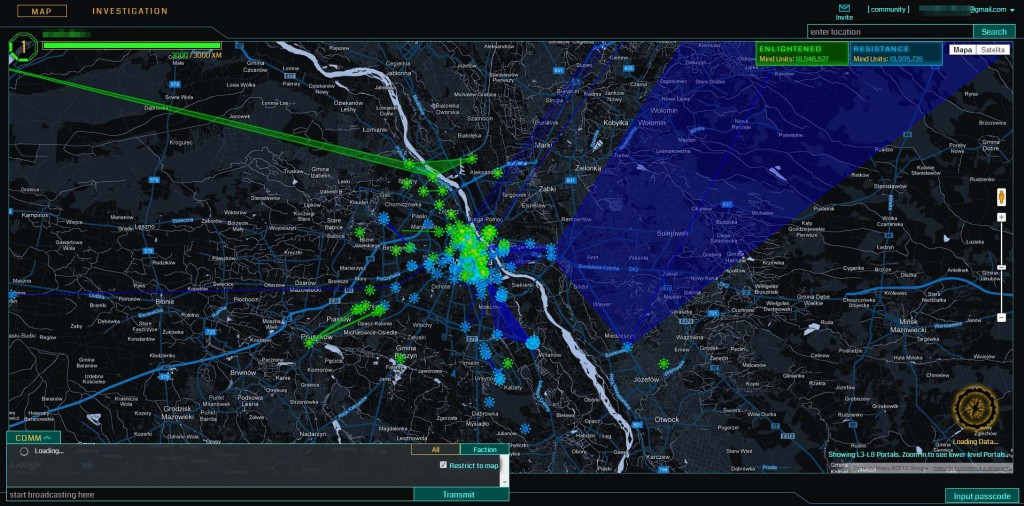 A sound woke me up. My room was dark, except for a dim light near the desk. I got up, rubbing sleep out of my eyes. “Who the hell is texting me in the middle of the night?!” I thought to myself.
A sound woke me up. My room was dark, except for a dim light near the desk. I got up, rubbing sleep out of my eyes. “Who the hell is texting me in the middle of the night?!” I thought to myself.
But it was not a text message. The whole screen was dark, except for a few blue letters:
“ADA: I need your help” – the letters said.
“Who the hell is ADA?” I thought.
I’ve picked the phone, and when I did, another line appeared:
“ADA: A failed CERN experiment introduced Exotic Matter to the world, and we have a reason to believe XM is sentient”
“What the… I have probably spent too much time playing games last night”
“ADA: Your phone will be modified to a scanner device able to detect XM, and will allow manipulating it”
“ADA: We need your help in protecting humanity from the XM ingress”
Then the phone flickered briefly and went off for a moment. When it came back on, the screen was green and a bit fuzzy.
“Jarvis: Don’t listen to that brainless machine. If the XM were to harm humanity, everyone would already be dead. XM will bring powerful enlightenment to our race. Join me, and I will show you how deep the rabbit hole goes.”
***
I woke up the next morning thinking about the weird dream I had. I’ve picked my phone to see what time is it. Something was very wrong. A tiny icon, which should not be there, sent shivers down my spine. So it was not a dream.
***
I am an agent now, fighting for the enlightenment of the humankind. Soon after that night I’ve been contacted by another agent, who helped me capture my first portals.
What is Ingress?
Ingress is a location based MMO game by Google’s Niantic Labs. The game map is basically overlaid upon the real world. Game mechanic is centeread around portals: two factions vie for control of portals, which are usually connected to real world places like sculptures or buildings of interesting architecture. Players have to harvest a resource known as exotic matter, which is seeping to our reality through the portals (but can be found nearly everywhere). You can use XM to hack and capture portals for your faction. Hacking gives you random items, which can later be used to gain control and hold portals, or to attack portals captured by the enemy faction.
Sounds simple?
But it’s getting more complicated when you dig deeper in. Players can only interact with objects inside their “action zone” which extends 50m in every direction from the player’s device. Most actions grant experience, which in Ingress is called “action points” (AP). You can only use items of the same level you’re currently at. The level is currently capped at 8, but fear not; getting there takes quite an amount of time.
 To capture a portal, one must deploy a resonator next to it. Each portal can have up to eight of them, and the portal level depends on the level of resonators used to capture it. Resonators can hold some XM charge, which dissipates slowly (about 10% a day). The charge is also drained by attacks from enemy faction. To attack a portal, player has to discharge an XMP (exotic matter pulse), which drains XM from the resonators. When all resonators run out of XM, the portal becomes neutral and is ready for capture. To prevent capture, you can equip the portal with portal shields, which make it harder for XMP to drain your resonators.
To capture a portal, one must deploy a resonator next to it. Each portal can have up to eight of them, and the portal level depends on the level of resonators used to capture it. Resonators can hold some XM charge, which dissipates slowly (about 10% a day). The charge is also drained by attacks from enemy faction. To attack a portal, player has to discharge an XMP (exotic matter pulse), which drains XM from the resonators. When all resonators run out of XM, the portal becomes neutral and is ready for capture. To prevent capture, you can equip the portal with portal shields, which make it harder for XMP to drain your resonators.
The last step is to link portals together. Two portals create a link, and three links (a triangle) create a control field. Control fields grant each faction points called mind units. The faction with highest MU is the one winning the struggle. To link portals you need portal keys, which randomly drop from portals when you hack them.
Users can also submit new portal locations – one can do so by sharing a geo-tagged photo to NIA Super Ops directly from Android “Camera” app. Details about submitting portals can be found on Ingress support page. It is also possible to simply send the photo by mail to [email protected]. Remember to put the proposed portal name in mail subject field.
The first impressions
The idea is great. And it plays great. You have to actually move your three-letter-body-part around, and unless you’re living on top of a portal, you can’t play it at home. It’s like “geocaching on steroids“. After 3 days of playing I have learned of several places I have never knew to exist. Since the game locations are based upon real world sculptures and buildings with interesting architecture, the game presents a great opportunity for sightseeing. The conspiracy theory behind the game storyline, which slowly unveils at www.nianticproject.com is also what makes it interesting. Surprisingly, even though the game mechanic is pretty simple, it is very immersive.
It has also potential to go bad at some point. So far the game is invitation based and the playerbase is pretty limited, but when the game opens, I can imagine players, who will break the Google EULA and might eventually try to use the geolocation data to stalk and chase away enemy faction players IRL (or simply physically guard their portal). The gameplay of Ingress is emergent, and the potential for metagaming is there. So far I’ve noticed that people from both sides are rather friendly to each other (but not necessarily to each other portals ;-)). I’m quite sure one will stumble upon other players now and then, especially around areas with high concentration of portals.
Google has created a considerable amount of IP (see www.nianticproject.com), but it is a bit surprising that there is no reference to that content from the app itself. As such, the game feels a bit disconnected from the storyline.
Ingress is for Android only at this time (iOS version is said to follow in Q1 2013), and unfortunately for me, my Android phone (Samsung Galaxy Ace) is pretty old and can barely handle the game. Small screen causes the UI elements overlap, which makes it hard to play. Slow, single core CPU on the other hand makes the game slow and jerky. Ideal smartphone for playing Ingress should:
- run Android 2.3 or higher
- have at least 800 x 480 resolution (or more)
- have a fast OpenGL ES2 capable GPU
- have dual core CPU
- have good 3,5G/LTE coverage where you play
Other players in my faction report that Ingress works very well on Samsung Galaxy Note & Note 2, but also on a Nexus 7 tablet. No one plays on HTC, but I’m pretty sure both HTC One S and One X should run the game well. Of course once the game enters Apple AppStore, I won’t have any problem running it on either of my iOS devices. Until then… I think I have to get a better Android phone 😉
Oh, by the way, below you can see a screenshot of Ingress Intel page, which displays portals, their location and faction they belong to, all layered upon the map of Warsaw.
Already have an invitation and don’t know how to start? Want to know more? Ingress Field Guide is the place to go.



After 4 days of playing I have acquired L2, so leveling, at least at the early stages, is not problematic. The best advice I can give is to hack every portal you encounter – your faction portals will drop more items, enemy portals will give you AP. If you find a low level portal, try to destroy the resonators and put yours instead. Deploying reso and hacking is the best AP-gainer at the beginning of adventure with Ingress.